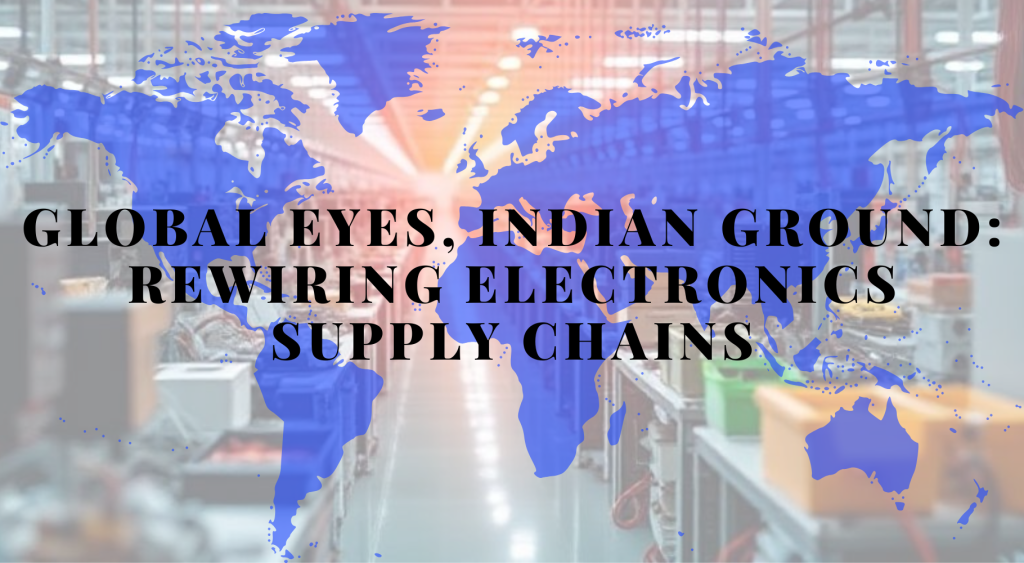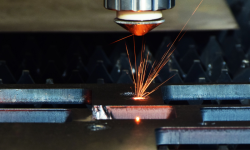
Have you ever wondered why India’s name keeps popping up when people talk about electronics these days?
Maybe you’ve seen headlines like, “Apple Moves Production to India” or “India Becomes a Hub for Semiconductors.” It’s not just news hype. The truth is, the world is genuinely shifting its focus toward India. And if you’re curious why, well — you’re in the right place.
Let’s break it down together, one simple thought at a time.

What’s the Big Deal with Supply Chains Anyway ?
First, let’s talk basics. What is a supply chain?
Think of it like this: when you buy a new smartphone, it’s not made in just one place. The screen might be made in Korea, the processor in Taiwan, the assembly in China — and it finally lands in your hands, maybe shipped from Vietnam or India.
That’s the supply chain. It’s the journey every electronic product goes through — from raw material to finished gadget.
But here’s the problem. What happens when one link in the chain breaks?
Yep, the whole thing slows down or stops. You’ve probably felt it — the delays, the price hikes, the “out of stock” signs. That’s why businesses and governments everywhere are starting to rethink where and how electronics get made.
So, Why Is Everyone Eyeing India Now?
Let’s start with the obvious question: why India?
Well, there isn’t just one reason. There are several. And together, they make India a pretty strong candidate for becoming the future backbone of electronics supply chains.
Let’s unpack them.
1. India Has the Numbers — And Not Just People
Yes, India has over 1.4 billion people. But it’s not just about population. It’s about skilled people. Every year, India produces millions of engineers, IT professionals, and technically trained workers. It’s a massive resource of skilled professionals for tech firms to leverage.
And the bonus? Labor here is still relatively affordable.
So, when you mix skills with cost-effectiveness — it’s a win for manufacturers.
2. Government Support Is Stronger Than Ever
You’ve probably heard about India’s “Make in India” initiative, right?
It’s not just a slogan. The Indian government has been putting serious money and muscle behind turning India into a global manufacturing hub. There are tax breaks, faster clearances, production-linked incentives (PLI), and policies that favor electronics manufacturing.
For example, the PLI scheme for electronics has already attracted major global players like Apple, Foxconn, and Samsung.
When the government supports something this actively — you know it’s serious.
3. China Plus One — What’s That All About?
Here’s something you might not have heard — “China Plus One.”
It’s a strategy that global companies are using. For years, China was the go-to place for making electronics. But now, because of rising costs, strict lockdowns, and geopolitical tensions, companies are feeling the risk of putting all their eggs in one basket.
So what do they do?
They look for another country to work alongside China — a “plus one.” And India? It’s the favorite “plus one
4. Huge Domestic Market = Built-In Demand
Did you know? India ranks as the second-largest smartphone market globally. What does that mean for companies?
Well, if you’re making electronics in India, you’re not just manufacturing for exports — you’re also making for a massive, tech-hungry domestic market.
That’s very attractive to global brands. They can make and sell in the same place. Less shipping. Faster delivery. Better margins.
5. Digital India and the Tech Boom
Ever noticed how everything in India is going digital?
From UPI payments to online schooling, from e-health to remote work — India is becoming one of the most connected countries on the planet. And this digital boom is driving the need for more gadgets, more infrastructure, and yes — more electronics.
So naturally, the demand for supply chain support has gone through the roof.
6. India’s Strategic Location Helps Too
Did you know India is just a short sail from the Middle East, Southeast Asia, and East Africa?
That makes logistics way easier. Indian ports like Chennai, Mumbai, and Vizag are modern and globally connected. Shipping to Europe or Africa from here? Super efficient.
And when time is money — location makes a big difference.
7. Infrastructure Is Getting a Makeover
Okay, let’s be honest. India’s infrastructure wasn’t always ideal.
But that’s changing. Fast.
New expressways, modern ports, air cargo terminals, high-speed rail links — they’re all coming together to support large-scale manufacturing. Industrial corridors and tech parks are being built near cities like Bengaluru, Pune, and Noida.
The setup is becoming world-class. And manufacturers love that.
8. Global Giants Are Already Here
Let’s talk proof.
Apple is now making the iPhone 15 in India. Foxconn, Wistron, Pegatron — all major Apple suppliers — are setting up factories across the country. Samsung already has one of the world’s biggest mobile factories in Noida. Dell and HP are planning assembly units.
The domino effect is real.
When these giants invest, their suppliers follow. When suppliers come, logistics improve. It all starts with India — and the impact just keeps spreading.
9. The Semiconductor Dream Is Taking Shape

Now, let’s get to the core — literally.
Semiconductors are the heart of all electronics. And until now, India wasn’t a player in chip manufacturing.
But that’s changing.
With massive investments (we’re talking billions of dollars), India is building semiconductor fabs — chip-making factories — in places like Gujarat and Tamil Nadu. The government is partnering with companies like Micron and Tower Semiconductor.
It’s still early days, but the signs are clear — India wants to make chips, not just assemble products.
10. Geopolitics Are Shifting the Game
You’ve probably noticed — the world is changing.
Trade wars, sanctions, and rising tensions have made global businesses more cautious. They don’t want to rely too much on one country. They’re looking for options. Stable ones.
And India, with its democratic setup, growing economy, and strong ties with the West, is becoming the preferred choice.
What Does This Mean for You ?
Now, you might be thinking — “Okay, great. But how does this affect me?”
Well, in more ways than you might imagine.
If you’re a business owner, it means better sourcing opportunities.
If you’re a tech enthusiast, it means more innovation coming from home turf.
If you’re a job seeker, it means more opportunities in manufacturing, tech, logistics, and design.
And if you’re just a consumer? Expect faster launches, more affordable gadgets, and quicker access to global tech.
Are There Challenges Too?
Of course. No country is perfect.
India still faces hurdles — red tape, land acquisition issues, electricity reliability, and training gaps in advanced manufacturing. But here’s the thing — the intent to fix them is real.
And progress? It’s visible.
Every month, there’s a new policy, a new factory inauguration, or a new international partnership. The momentum is strong.
India Is Not Just Catching Up — It’s Leading the Way
Let’s zoom out for a second.
Twenty years ago, India was known mainly for IT services and call centers. Then came software, startups, and SaaS unicorns.
Now, it’s manufacturing’s turn.
India isn’t just playing catch-up anymore. It’s shaping the next chapter. The way supply chains are re-aligning — India is slowly becoming the go-to place for electronics design, production, and even research.
What’s the Future Looking Like?
If you’re still with me, let’s imagine the future for a minute.
It’s 2030. You walk into a store and pick up the latest phone. The chip inside? Designed in Bengaluru. The screen? Sourced locally. The final assembly? Done in Pune. Even the packaging? All made in India.
And it doesn’t stop at phones.
Smart TVs. Laptops. Servers. Smart watches. Medical electronics. EV components.
From start to finish, the value chain could soon be Indian-made.
Not just because of pride — but because it’s faster, smarter, and more efficient.
So, What Can You Do?
Great question.
If you’re a business leader, maybe it’s time to look into Indian suppliers.
If you’re a student or young professional — consider careers in hardware, electronics design, or manufacturing tech.
If you’re an investor, keep an eye on Indian tech parks and electronics clusters.
And if you’re a policymaker — keep enabling this shift with strong infrastructure and skilling programs.
Final Thoughts
Look, we’re not saying India will replace every country in the supply chain. That’s not how the global economy works.
But India is fast becoming a key player. A trusted partner. A crucial link.
And if the current trends continue — which all signs suggest they will — then the next decade of electronics will be designed, built, and shipped with India at its heart.










